State of Research on Gamification in Education: A Bibliometric Survey
Abstract
:1. Introduction
2. Materials and Methods
- Survey planning: Selection of data sources and specification of search criteria.
- Preliminary analysis: Answering RQ1 and selecting the data source which provides the widest coverage of the scientific output with regard to gamification in education for further analysis.
- Main analysis: Answering the remaining RQs.
- they index the largest number of documents, far exceeding the other databases;
- most of the content of commercial publisher databases (e.g., Springer Link and ScienceDirect) is indexed by at least one of the three selected data sources;
- most of the other databases used in prior research (e.g., ACM Digital Library; AISeL, ASME Digital Collection, IEEE Xplore) are dedicated to specific topic areas (such as computer science, information systems, or mechanical engineering), and this survey was not restricted to any of these areas;
- ERIC is a database dedicated to an area consistent with the scope of the survey (education); however, it does not provide citation data which automatically excludes its use in the main analysis stage. Note that a simple query for peer-reviewed publications on “education” and “gamification” resulted in 262 items, which, while a small fraction of the number of items retrieved from the other sources, makes it a source to consider in future literature surveys on gamification in education.
- a paper relevant to gamification should have the term “gamification” mentioned in its title, keywords, or abstract;
- a paper relevant to education should either have the term “education” or “educational” mentioned in its title or keywords (we ignore abstracts here, as many papers on gamification in non-educational contexts mention education as an exemplary field of gamification in their abstracts), or be published in an educational context (in a journal, book, or proceedings of a conference dedicated to education).
- papers from 2021 should be excluded (to avoid the false impression that the results cover the scientific output from 2021, whereas only few publications with such a publication date were found);
- papers not in English should be excluded (to avoid the false impression that the results cover scientific output in non-English languages, whereas only a small amount of such publications were found; a proper survey in this vein should include various national-level bibliographic databases);
- only the publications in the type of book, chapter, journal article, and conference paper should be included (to exclude all publications such as reviews, editorials, etc. that do not convey new research results).
- in Scopus: “(PUBYEAR < 2021) AND TITLE-ABS-KEY (gamification) AND (TITLE (education*) OR KEY (education*) OR CONFNAME (education*) OR SRCTITLE (education*)) AND (LIMIT-TO (DOCTYPE, “cp”) OR LIMIT-TO (DOCTYPE, “ar”) OR LIMIT-TO (DOCTYPE, “ch”) OR LIMIT-TO (DOCTYPE, “bk”)) AND (LIMIT-TO (LANGUAGE, “English”))”,
- in Web of Science: “(((TI = gamification OR AK = gamification OR AB = gamification) AND (TI = education* OR AK = education* OR SO = education* OR CF = education*) )) AND LANGUAGE: (English) AND DOCUMENT TYPES: (Article OR Book OR Book Chapter OR Proceedings Paper)”, with the following additional search criteria: “Indexes = SCI-EXPANDED, SSCI, A&HCI, CPCI-S, CPCI-SSH, BKCI-S, BKCI-SSH, ESCI Timespan = 1900–2020”.
3. Results
3.1. Preliminary Analysis
3.2. Main Analysis
3.2.1. Geographic Distribution of Scientific Contribution
3.2.2. Forms of Publication
3.2.3. Addressed Research Areas and Topics
3.2.4. Dissemination Channels
3.2.5. Most Involved Scientific Institutions
3.2.6. Research Leaders
3.2.7. Research Collaboration
3.2.8. Research Impact
4. Discussion and Conclusions
- Computer Science is a somewhat difficult subject of education, therefore the support for engagement and motivation offered by gamification is especially demanded (note also the high interest from the fields of Engineering and Mathematics);
- Computer Science subjects are mostly taught using computers, making it easy to introduce gamification software in the process compared to subjects traditionally taught without the use of computers;
- a considerable part of publications on gamification in education is devoted to presentation of new software tools, which, regardless of the area of education they are applied to, are often published in Computer-Science-related venues.
Funding
Institutional Review Board Statement
Informed Consent Statement
Data Availability Statement
Conflicts of Interest
References
- Kapp, K.M. The Gamification of Learning and Instruction: Game-Based Methods and Strategies for Training and Education; Pfeiffer: San Francisco, CA, USA, 2012. [Google Scholar]
- Lamrani, R.; Abdelwahed, E.H.; Chraibi, S.; Qassimi, S.; Hafidi, M. Gamification and Serious Games Based Learning for Early Childhood in Rural Areas. New Trends in Model and Data Engineering; Abdelwahed, E.H., Bellatreche, L., Benslimane, D., Golfarelli, M., Jean, S., Mery, D., Nakamatsu, K., Ordonez, C., Eds.; Springer: Cham, Switzerland, 2018; pp. 79–90. [Google Scholar]
- Alshammari, M.T. Evaluation of Gamification in E-Learning Systems for Elementary School Students. TEM J. 2020, 9, 806–813. [Google Scholar] [CrossRef]
- Buzko, V.; Bonk, A.; Tron, V. Implementation of Gamification and Elements of Augmented Reality during the Binary Lessons in a Secondary School. Pedahohika Vyshchoï Serednoï Shkoly 2018, 51, 74–83. [Google Scholar] [CrossRef] [Green Version]
- Varannai, I.; Sasvari, P.; Urbanovics, A. The Use of Gamification in Higher Education: An Empirical Study. Int. J. Adv. Comput. Sci. Appl. 2017, 8. [Google Scholar] [CrossRef] [Green Version]
- Abdulmenaf, G.; Cigdem, U.B. Gamification in Adult Learning. In Handbook of Research on Adult Learning in Higher Education; Mabel, C.P.O., Tinukwa, O., Boulder, C., Eds.; IGI Global: Hershey, PA, USA, 2020; pp. 570–597. [Google Scholar] [CrossRef]
- Denny, P.; McDonald, F.; Empson, R.; Kelly, P.; Petersen, A. Empirical Support for a Causal Relationship Between Gamification and Learning Outcomes. In Proceedings of the 2018 CHI Conference on Human Factors in Computing Systems—CHI’18, Montreal, QC, Canada, 21–26 April 2018; ACM Press: Montreal, QC, Canada, 2018; pp. 1–13. [Google Scholar] [CrossRef]
- Sánchez-Sepúlveda, M.; Fonseca, D.; Calvo, X.; Navarro, I.; Franquesa, J.; Redondo, E.; Gené, M. Innovation in Urban Design Education. In Proceedings of the Sixth International Conference on Technological Ecosystems for Enhancing Multiculturality—TEEM’18, Salamanca, Spain, 24–26 October 2018; ACM Press: Salamanca, Spain, 2018; pp. 729–736. [Google Scholar] [CrossRef] [Green Version]
- Kasahara, R.; Sakamoto, K.; Washizaki, H.; Fukazawa, Y. Applying Gamification to Motivate Students to Write High-Quality Code in Programming Assignments. In Proceedings of the 2019 ACM Conference on Innovation and Technology in Computer Science Education—ITiCSE ’19, Aberdeen, Scotland, 15–17 July 2019; Association for Computing Machinery: New York, NY, USA, 2019; pp. 92–98. [Google Scholar]
- Broman, K.; Maarell-Olsson, E. Application of Digital Tools in Chemistry Education: Virtual Reality, Augmented Reality and Gamification. 2019 ESERA; Umeå University, Interactive Media and Learning (IML): Umeå, Sweden, 2019. [Google Scholar]
- Goehle, G. Gamification and Web-based Homework. PRIMUS 2013, 23, 234–246. [Google Scholar] [CrossRef]
- Chapman, J.R.; Rich, P.J. Does educational gamification improve students’ motivation? If so, which game elements work best? J. Educ. Bus. 2018, 93, 315–322. [Google Scholar] [CrossRef]
- Dermeval, D.; Albuquerque, J.; Bittencourt, I.I.; Isotani, S.; Silva, A.P.; Vassileva, J. GaTO: An Ontological Model to Apply Gamification in Intelligent Tutoring Systems. Front. Artif. Intell. 2019, 2, 13. [Google Scholar] [CrossRef] [Green Version]
- Swacha, J.; Queirós, R.; Paiva, J.C.; Leal, J.P.; Kosta, S.; Montella, R. A Roadmap to Gamify Programming Education. In Proceedings of the First International Computer Programming Education Conference (ICPEC 2020), Porto, Portugal, 23–24 April 2020; Schloss Dagstuhl-Leibniz-Zentrum für Informatik: Wadern, Germany, 2020. [Google Scholar]
- Tenório, K.; Chalco Challco, G.; Dermeval, D.; Lemos, B.; Nascimento, P.; Santos, R.; Pedro da Silva, A. Helping Teachers Assist Their Students in Gamified Adaptive Educational Systems: Towards a Gamification Analytics Tool. In Artificial Intelligence in Education; Bittencourt, I.I., Cukurova, M., Muldner, K., Luckin, R., Millán, E., Eds.; Springer: Cham, Switzerland, 2020; pp. 312–317. [Google Scholar]
- Hanus, M.D.; Fox, J. Assessing the effects of gamification in the classroom: A longitudinal study on intrinsic motivation, social comparison, satisfaction, effort, and academic performance. Comput. Educ. 2015, 80, 152–161. [Google Scholar] [CrossRef]
- De Sousa Borges, S.; Durelli, V.H.S.; Reis, H.M.; Isotani, S. A systematic mapping on gamification applied to education. In Proceedings of the 29th Annual ACM Symposium on Applied Computing, Gyeongju, Korea, 24–28 March 2014; ACM: Gyeongju, Korea, 2014; pp. 216–222. [Google Scholar] [CrossRef]
- Grosseck, G.; Malita, L.; Sacha, G.M. Gamification in Higher Education: A Bibliometric Approach. In Proceedings of the 16th International Scientific Conference—eLearning and Software for Education, Bucharest, Romania, 30 April–1 May 2020; eLSE: Bucharest, Romania, 2020; pp. 20–30. [Google Scholar]
- Kocakoyun, S.; Ozdamli, F. A Review of Research on Gamification Approach in Education. In Socialization—A Multidimensional Perspective; Morese, R., Palermo, S., Nervo, J., Eds.; IntechOpen: London, UK, 2018. [Google Scholar] [CrossRef] [Green Version]
- Silva, R.J.R.; Rodrigues, R.G.; Leal, C.T.P. Gamification in Management Education: A Systematic Literature Review. BAR Braz. Adm. Rev. 2019, 16, e180103. [Google Scholar] [CrossRef] [Green Version]
- Martí-Parreño, J.; Méndez-Ibáñez, E.; Alonso-Arroyo, A. The use of gamification in education: A bibliometric and text mining analysis: Gamification in education. J. Comput. Assist. Learn. 2016, 32, 663–676. [Google Scholar] [CrossRef]
- Majuri, J.; Koivisto, J.; Hamari, J. Gamification of Education and Learning: A Review of Empirical Literature. In Proceedings of the 2nd International GamiFIN conference, Pori, Finland, 21–23 May 2018; pp. 11–19. [Google Scholar]
- Caponetto, I.; Earp, J.; Ott, M. Gamification and Education: A Literature. In Proceedings of the ECGBL 2014: Eighth European Conference on Games Based Learning, Berlin, Germany, 9–10 October 2014; pp. 50–57. [Google Scholar]
- De Fabricio, C. Using gamification in education: A systematic literature review. In Proceedings of the International Conference on Information Systems 2018—ICIS 2018, San Francisco, CA, USA, 13–16 December 2018. [Google Scholar]
- Legaki, N.; Hamari, J. Gamification in statistics education: A literature review. CEUR Workshop Proc. 2020, 2637, 41–51. [Google Scholar]
- Milosz, M.; Milosz, E. Gamification in Engineering Education—A Preliminary Literature Review. In Proceedings of the 2020 IEEE Global Engineering Education Conference (EDUCON), Porto, Portugal, 28–30 April 2020; pp. 1975–1979. [Google Scholar] [CrossRef]
- Klock, A.; Gasparini, I.; Pimenta, M.; Hamari, J. Tailored gamification: A review of literature. Int. J. Hum. Comput. Stud. 2020, 144, 102495. [Google Scholar] [CrossRef]
- Dicheva, D.; Dichev, C. Gamification in Education: Where Are We in 2015? In Proceedings of the E-Learn: World Conference on E-Learning in Corporate, Government, Healthcare, and Higher Education 2015, Kona, HI, USA, 19 October 2015; Association for the Advancement of Computing in Education (AACE): Kona, HI, USA, 2015; pp. 1445–1454. [Google Scholar]
- Subhash, S.; Cudney, E.A. Gamified learning in higher education: A systematic review of the literature. Comput. Hum. Behav. 2018, 87, 192–206. [Google Scholar] [CrossRef]
- Osatuyi, B.; Osatuyi, T.; de la Rosa, R. Systematic Review of Gamification Research in Is Education: A Multi-method Approach. Commun. Assoc. Inf. Syst. 2018, 42, 95–124. [Google Scholar] [CrossRef]
- Indriasari, T.; Luxton-Reilly, A.; Denny, P. Gamification of student peer review in education: A systematic literature review. Educ. Inf. Technol. 2020, 25, 5205–5234. [Google Scholar] [CrossRef]
- Dicheva, D.; Dichev, C.; Agre, G.; Angelova, G. Gamification in education: A systematic mapping study. Educ. Technol. Soc. 2015, 18, 75–88. [Google Scholar]
- Ortega-Arranz, A.; Muñoz-Cristóbal, J.A.; Martínez-Monés, A.; Bote-Lorenzo, M.L.; Asensio-Pérez, J.I. How Gamification Is Being Implemented in MOOCs? A Systematic Literature Review. In Data Driven Approaches in Digital Education; Lavoué, E., Drachsler, H., Verbert, K., Broisin, J., Pérez-Sanagustín, M., Eds.; Springer: Cham, Switzerland, 2017; pp. 441–447. [Google Scholar]
- Ortiz Rojas, M.E.; Chiluiza, K.; Valcke, M. Gamification in higher education and STEM: A systematic review of literature. In Proceedings of the Edulearn16: 8th International Conference on Education and New Learning Technologies, Barcelona, Spain, 4–6 July 2016; IATED: Barcelona, Spain, 2016; pp. 6548–6558. [Google Scholar]
- Hamari, J.; Koivisto, J.; Sarsa, H. Does Gamification Work?—A Literature Review of Empirical Studies on Gamification. In Proceedings of the 47th Annual Hawaii International Conference on System Sciences, Waikoloa, HI, USA, 6–9 January 2014; pp. 3025–3034. [Google Scholar] [CrossRef]
- Alhammad, M.M.; Moreno, A.M. Gamification in software engineering education: A systematic mapping. J. Syst. Softw. 2018, 141, 131–150. [Google Scholar] [CrossRef]
- Hallifax, S.; Serna, A.; Marty, J.C.; Lavoué, E. Adaptive Gamification in Education: A Literature Review of Current Trends and Developments. In Transforming Learning with Meaningful Technologies; Scheffel, M., Broisin, J., Pammer-Schindler, V., Ioan-nou, A., Schneider, J., Eds.; Springer: Cham, Switzerland, 2019; pp. 294–307. [Google Scholar]
- Gari, M.; Radermacher, A. Gamification in Computer Science Education: A Systematic Literature Review. In Proceedings of the 2018 ASEE Annual Conference and Exposition, Salt Lake City, UT, USA, 23–27 June 2018; Volume 2018. [Google Scholar]
- Nicholas, D.; Ritchie, M. Literature and Bibliometrics; OCLC: 3380191; Bingley: London, UK, 1978. [Google Scholar]
- Schaller, A.A.; Vatananan-Thesenvitz, R.; Pulsiri, N.; Schaller, A.M. The Rise of Digital Business Models: An Analysis of the Knowledge Base. In Proceedings of the 2019 Portland International Conference on Management of Engineering and Technology (PICMET), Portland, OR, USA, 25–29 August 2019; IEEE: Piscataway, NJ, USA, 2019; pp. 1–13. [Google Scholar]
- Baker, N.C.; Ekins, S.; Williams, A.J.; Tropsha, A. A bibliometric review of drug repurposing. Drug Discov. Today 2018, 23, 661–672. [Google Scholar] [CrossRef] [PubMed]
- Yoopetch, C.; Nimsai, S. Science Mapping the Knowledge Base on Sustainable Tourism Development, 1990–2018. Sustainability 2019, 11, 3631. [Google Scholar] [CrossRef] [Green Version]
- Hallinger, P.; Chatpinyakoop, C. A Bibliometric Review of Research on Higher Education for Sustainable Development, 1998–2018. Sustainability 2019, 11, 2401. [Google Scholar] [CrossRef] [Green Version]
- Giustini, D.; Boulos, M.N.K. Google Scholar is not enough to be used alone for systematic reviews. Online J. Public Health Inform. 2013, 5, 214. [Google Scholar] [CrossRef] [Green Version]
- Aksnes, D.W.; Sivertsen, G. A Criteria-based Assessment of the Coverage of Scopus and Web of Science. J. Data Inf. Sci. 2019, 4, 1–21. [Google Scholar] [CrossRef] [Green Version]
- Van Eck, N.J.; Waltman, L. Software survey: VOSviewer, a computer program for bibliometric mapping. Scientometrics 2010, 84, 523–538. [Google Scholar] [CrossRef] [PubMed] [Green Version]
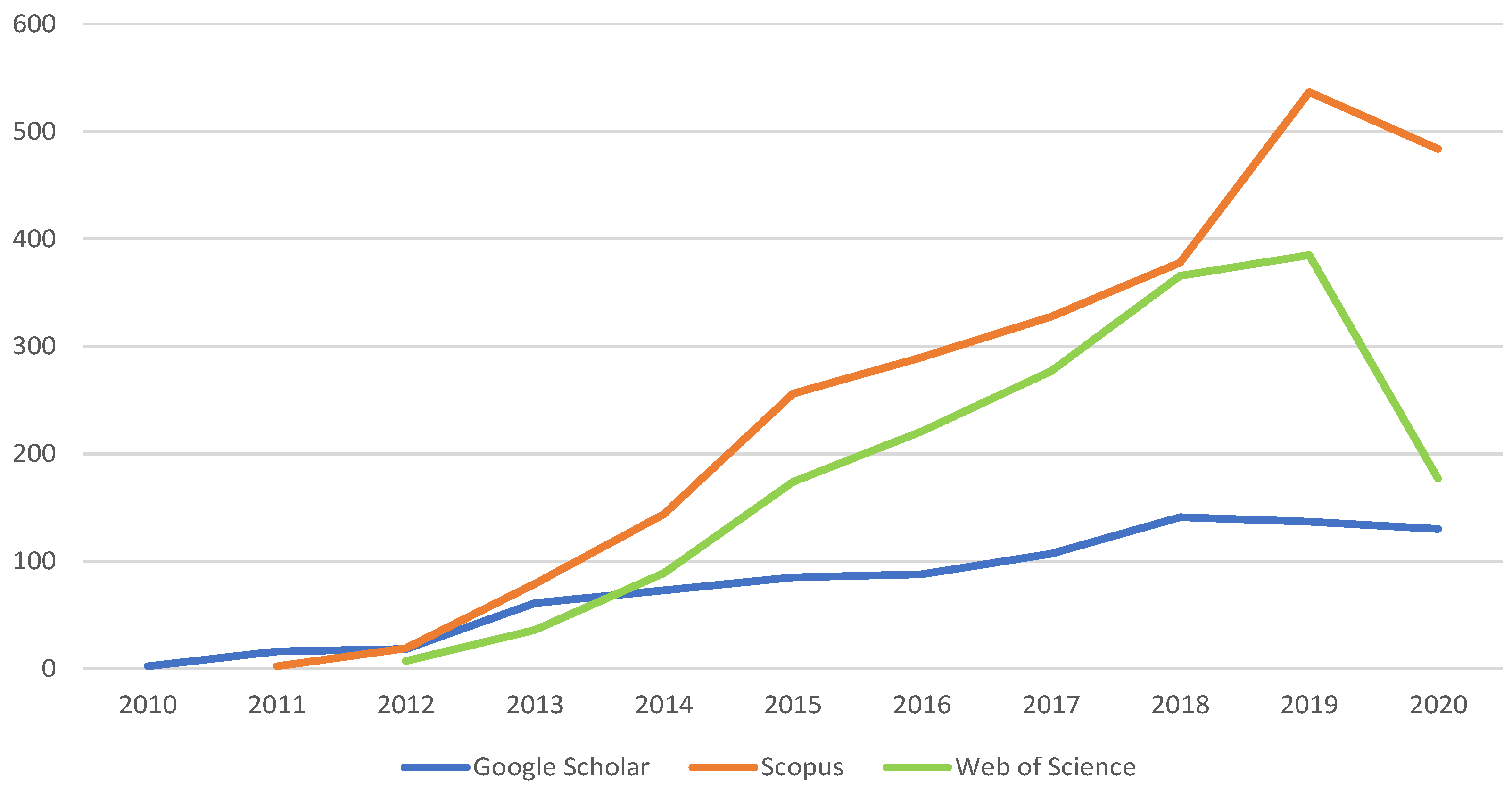

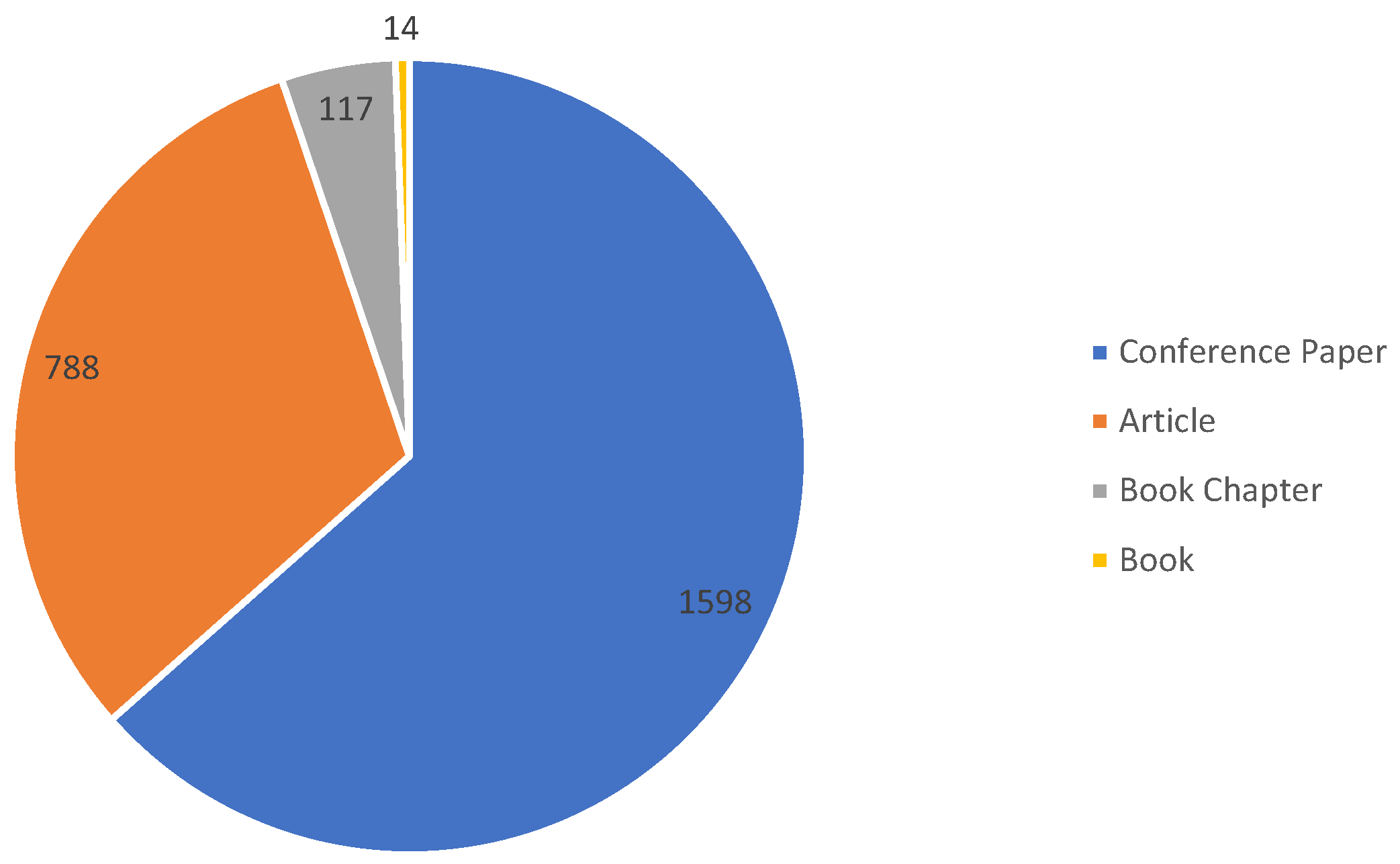
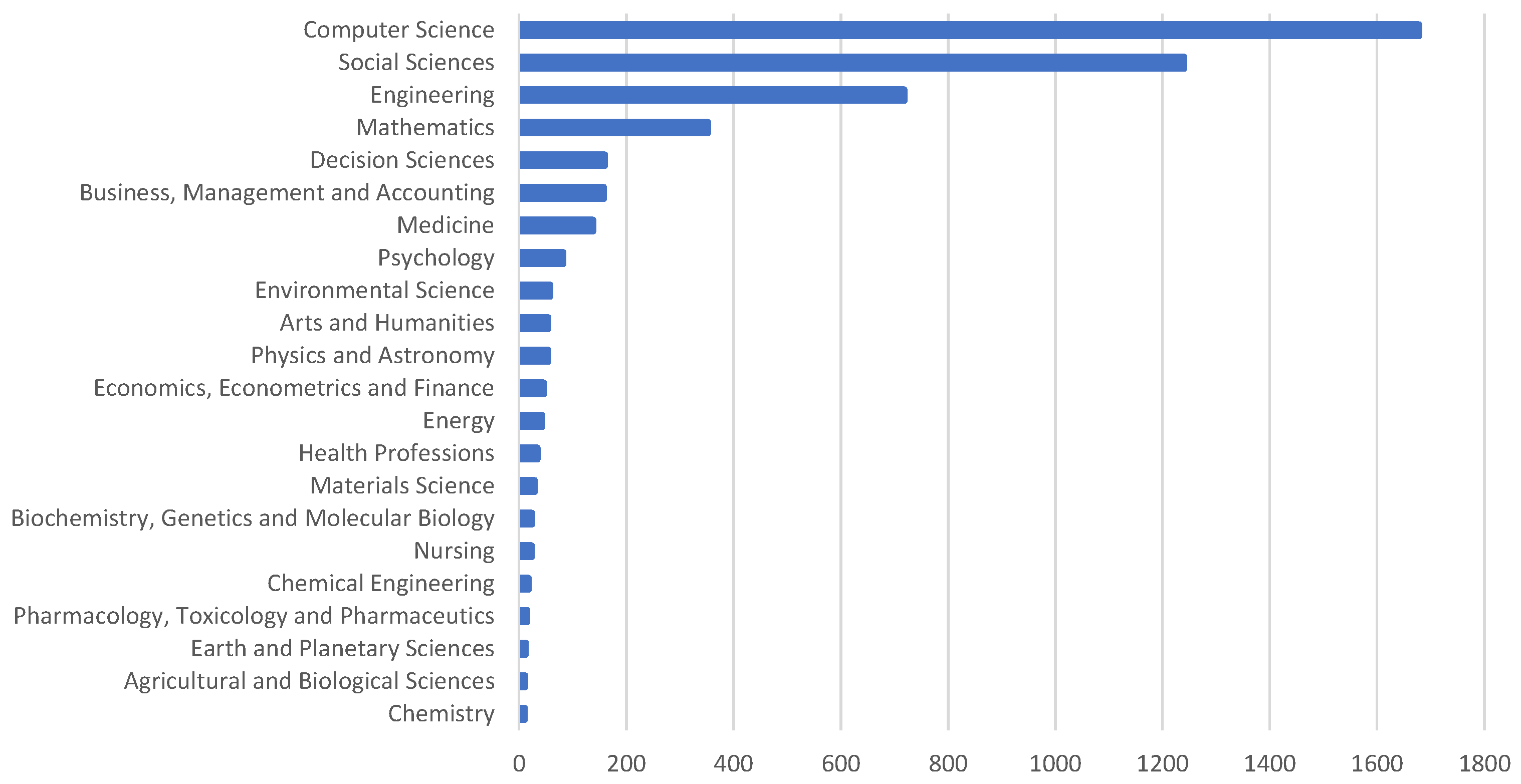
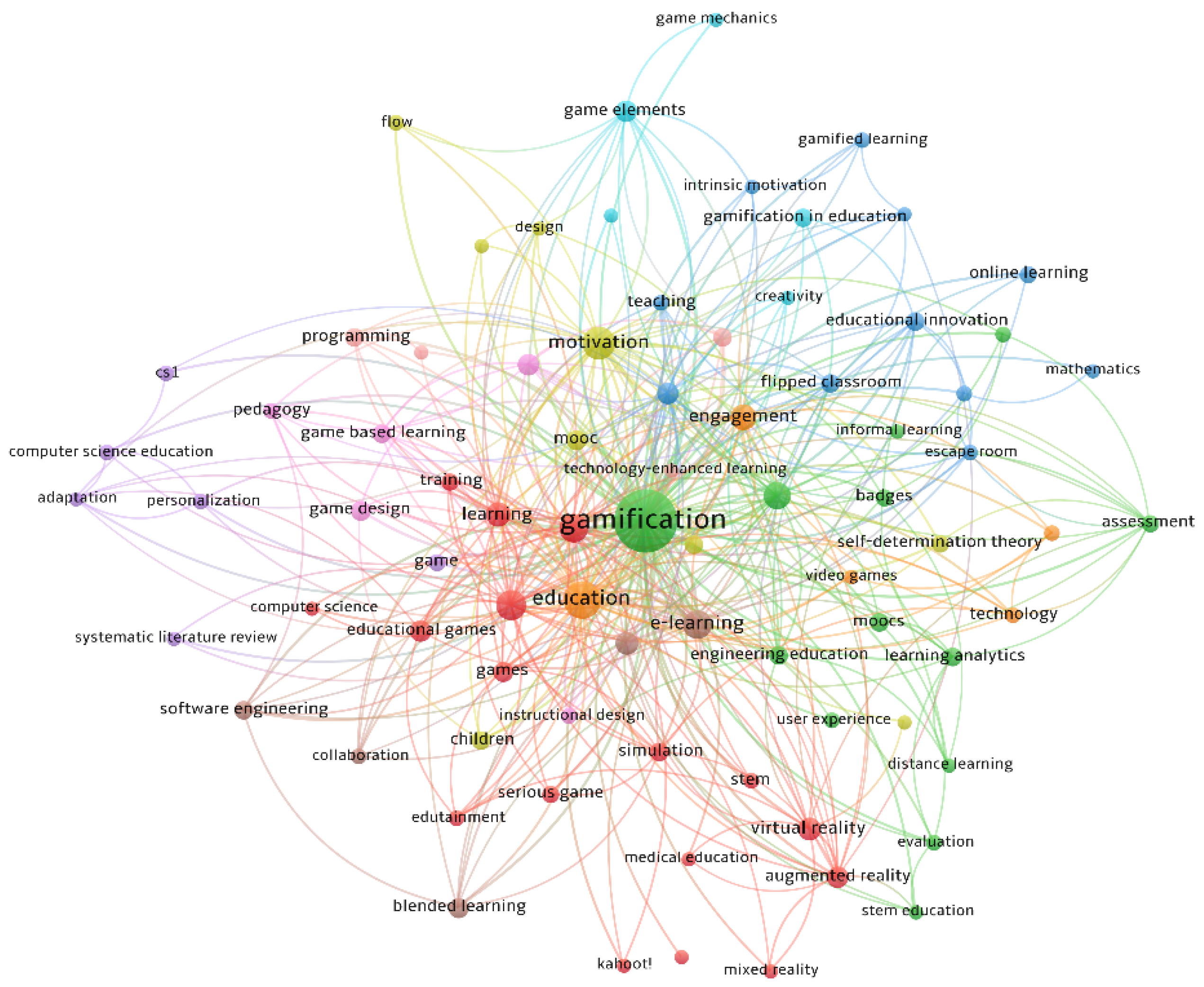

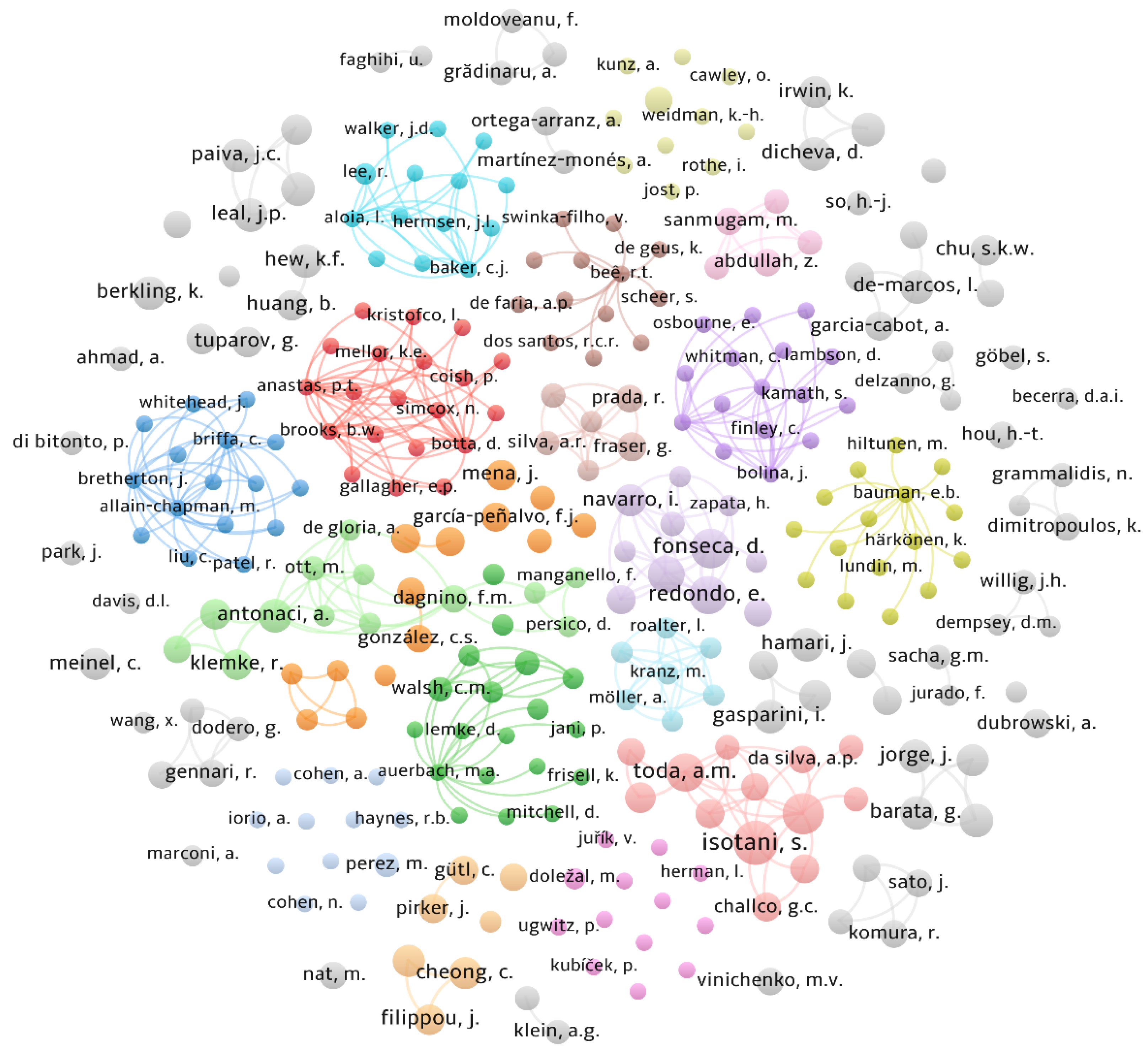
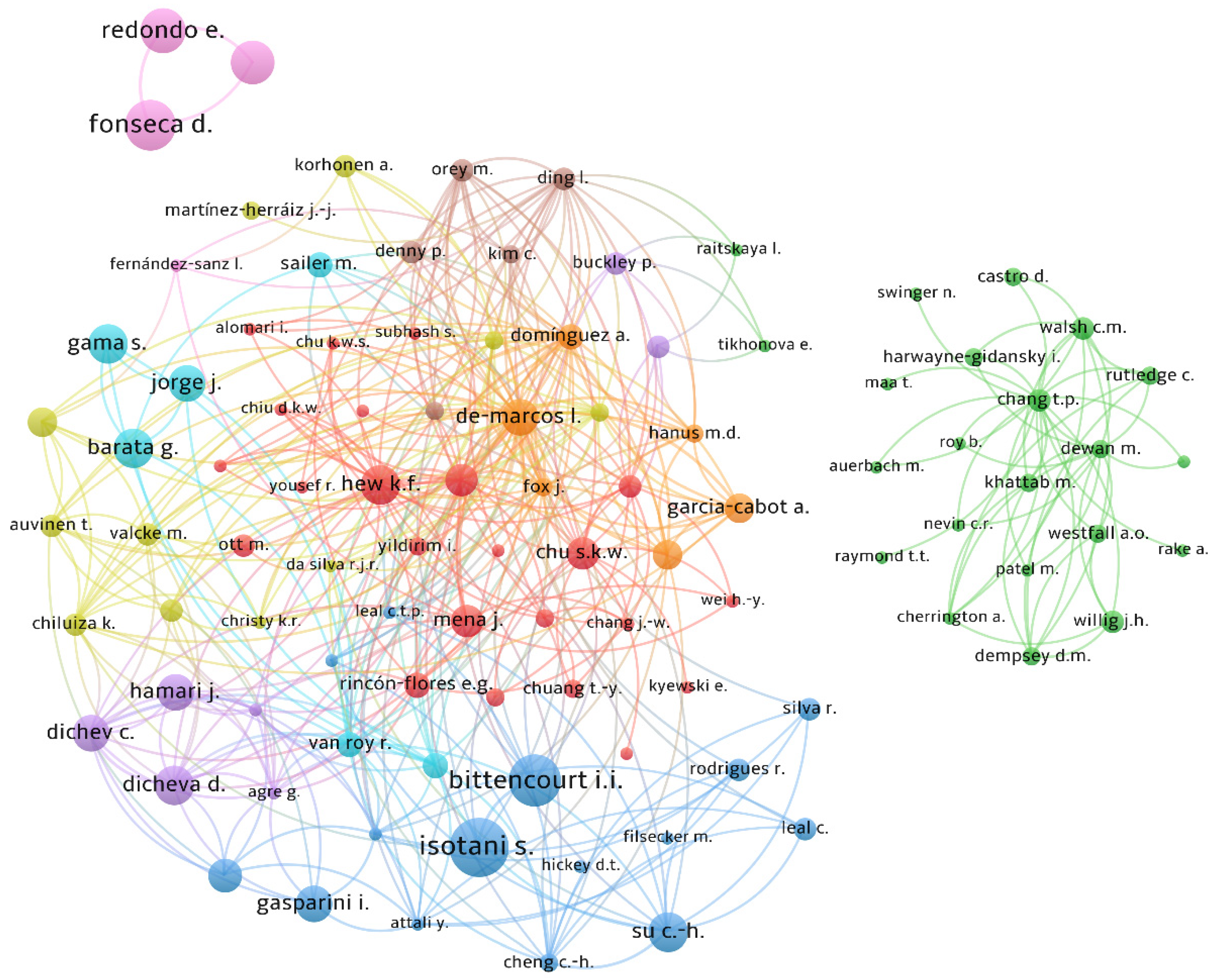
| Reference | Scope | Items | Databases 1 | Year |
|---|---|---|---|---|
| [18] | Higher education | 1029 | WoS | 2019 |
| [19] | (unrestricted) | 313 | WoS | 2018 |
| [20] | Management | 244 | Scopus, WoS | 2017 |
| [21] | (unrestricted) | 139 | WoS | 2014 |
| [22] | Empirical research | 128 | Scopus | 2015 |
| [23] | (unrestricted) | 119 | Scholar, WoS, Scopus, ResearchGate, Academia | 2014 |
| [24] | (unrestricted) | 95 | EBSCO, ScienceDirect, AISeL | 2018 |
| [25] | Statistics | 49 | Scopus, AISeL | 2019 |
| [26] | Engineering | 48 | IEEE | 2019 |
| [27] | Tailored gamification | 42 | ACM, IEEE, ScienceDirect, Scopus, Springer | 2019 |
| [28] | Empirical research | 41 | ACM, IEEE, ScienceDirect, Scopus, ERIC, Scholar | 2015 |
| [29] | Higher education | 41 | ACM, EBSCO, ASME, IEEE, PsychINFO, Scopus | 2017 |
| [30] | Information Systems | 41 | AISeL, ACM | 2016 |
| [31] | Peer review | 39 | ACM, IEEE, ScienceDirect, Springer, Scopus, WoS, ERIC | 2018 |
| [32] | Empirical research | 34 | ACM, IEEE, ScienceDirect, Scopus, Springer, ERIC, Scholar | 2014 |
| [33] | MOOCs | 34 | ACM, IEEE, ScienceDirect, Scopus, Springer, | 2017 |
| [34] | Higher education/STEM | 30 | WoS | 2016 |
| [17] | (unrestricted) | 26 | ACM, ScienceDirect, IEEE, Scopus, Springer | 2013 |
| [35] | Empirical research | 24 | EBSCO, Proquest, WoS, Scopus, ScienceDirect, Scholar, ACM, AISeL | 2013 |
| [36] | Software engineering | 21 | ACM, IEEE, Scopus, ScienceDirect, WoS | 2017 |
| [37] | Adaptive gamification | 20 | ACM, IEEE, ScienceDirect, Springer, Scholar | 2019 |
| [38] | Computer Science | 16 | ACM, IEEE, ProQuest, Web of Science | 2017 |
| Database | Google Scholar | Scopus | Web of Science | Duplicates | Coverage |
|---|---|---|---|---|---|
| Google Scholar | 66.7% | 10.2% | 6.2% | 16.8% | 20.7% |
| Scopus | 4.0% | 62.3% | 28.3% | 5.4% | 60.4% |
| Web of Science | 3.5% | 40.9% | 48.7% | 6.9% | 41.1% |
| Institution | Country | Share |
|---|---|---|
| Tecnologico de Monterrey | Mexico | 1.4% |
| Universidade de Sao Paulo—USP | Brazil | 1.0% |
| Universidad de Salamanca | Spain | 0.9% |
| Universidade Federal de Alagoas | Brazil | 0.8% |
| The University of Hong Kong | Hong Kong | 0.8% |
| Technische Universitat Graz | Austria | 0.8% |
| Universitat Ramon Llull | Spain | 0.8% |
| Universidade de Lisboa | Portugal | 0.8% |
| University of Toronto | Canada | 0.7% |
| Universidad Politécnica de Madrid | Spain | 0.7% |
| Universidad de la Laguna | Spain | 0.6% |
| Universitat Politècnica de Catalunya | Spain | 0.6% |
| Universidad Rey Juan Carlos | Spain | 0.6% |
| Pennsylvania State University | USA | 0.6% |
| Open University of the Netherlands | the Netherlands | 0.6% |
| IESCID Lisboa | Portugal | 0.6% |
| Universidad de Granada | Spain | 0.5% |
| Panepistimion Patron | Greece | 0.5% |
| Curtin University | Australia | 0.5% |
| Kazan Federal University | Russia | 0.5% |
| Author | Country | Works |
|---|---|---|
| Isotani, S. | Brazil | 21 |
| Bittencourt, I.I. | Brazil | 16 |
| Fonseca, D. | Spain | 15 |
| Toda, A.M. | Brazil | 13 |
| Berkling, K. | Germany | 11 |
| Hew, K.F. | Hong Kong | 11 |
| Villagrasa, S. | Spain | 11 |
| Antonaci, A. | the Netherlands | 10 |
| Barata, G. | Portugal | 9 |
| Dicheva, D. | USA | 9 |
| Gama, S. | Portugal | 9 |
| Gasparini, I. | Brazil | 9 |
| Paiva, J.C. | Portugal | 9 |
| Su, C.H. | Taiwan | 9 |
| Dichev, C. | USA | 8 |
| Hamari, J. | Finland | 8 |
| Huang, B. | Hong Kong | 8 |
| Jorge, J. | Portugal | 8 |
| Klock, A.C.T. | Finland | 8 |
| Leal, J.P. | Portugal | 8 |
| Meinel, C. | Germany | 8 |
| Queirós, R. | Portugal | 8 |
| Redondo, E. | Spain | 8 |
| Sillaots, M. | Estonia | 8 |
| Title | Authors | Year | Venue | Cited |
|---|---|---|---|---|
| Gamifying learning experiences: Practical implications and outcomes | Domínguez A., Saenz-De-Navarrete J., De-Marcos L., Fernández-Sanz L., Pagés C., Martínez-Herráiz J.-J. | 2013 | Computers and Education | 712 |
| Assessing the effects of gamification in the classroom | Hanus M.D., Fox J. | 2015 | Computers and Education | 528 |
| Defining gamification—A service marketing perspective | Huotari K., Hamari J. | 2012 | MindTrek Conference | 523 |
| Gamification in education: A systematic mapping study | Dicheva D., Dichev C., Agre G., Angelova G. | 2015 | Educational Technology and Society | 519 |
| An empirical study comparing gamification and social networking on e-learning | De-Marcos L., Domínguez A., Saenz-De-Navarrete J., Pagés C. | 2014 | Computers and Education | 249 |
| The effect of virtual achievements on student engagement | Denny P. | 2013 | Conference on Human Factors in Computing Systems | 229 |
| Foundations of Game-Based Learning | Plass J.L., Homer B.D., Kinzer C.K. | 2015 | Educational Psychologist | 197 |
| A recipe for meaningful gamification | Nicholson S. | 2015 | Gamification in Education and Business | 187 |
| A mobile gamification learning system for improving the learning motivation and achievements | Su C.-H., Cheng C.-H. | 2015 | Journal of Computer Assisted Learning | 186 |
| A systematic mapping on gamification applied to education | De Sousa Borges S., Durelli V.H.S., Reis H.M., Isotani S. | 2014 | ACM Symposium on Applied Computing | 172 |
| Gamification and serious games for personalized health | McCallum S. | 2012 | Studies in Health Technology and Informatics | 158 |
| Digital badges in education | Gibson D., Ostashewski N., Flintoff K., Grant S., Knight E. | 2015 | Education and Information Technologies | 150 |
Publisher’s Note: MDPI stays neutral with regard to jurisdictional claims in published maps and institutional affiliations. |
© 2021 by the author. Licensee MDPI, Basel, Switzerland. This article is an open access article distributed under the terms and conditions of the Creative Commons Attribution (CC BY) license (http://creativecommons.org/licenses/by/4.0/).
Share and Cite
Swacha, J. State of Research on Gamification in Education: A Bibliometric Survey. Educ. Sci. 2021, 11, 69. https://doi.org/10.3390/educsci11020069
Swacha J. State of Research on Gamification in Education: A Bibliometric Survey. Education Sciences. 2021; 11(2):69. https://doi.org/10.3390/educsci11020069
Chicago/Turabian StyleSwacha, Jakub. 2021. "State of Research on Gamification in Education: A Bibliometric Survey" Education Sciences 11, no. 2: 69. https://doi.org/10.3390/educsci11020069






